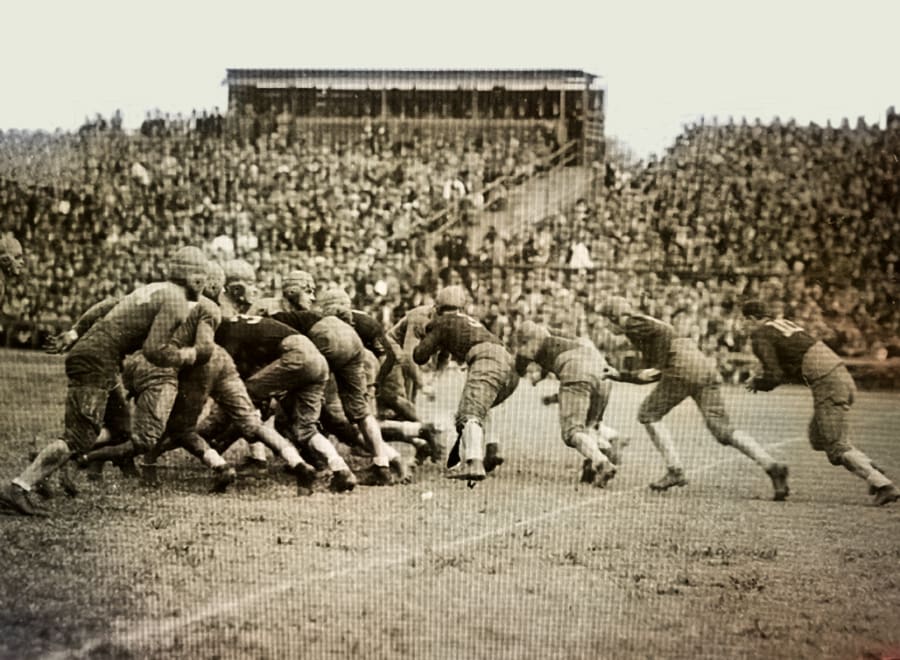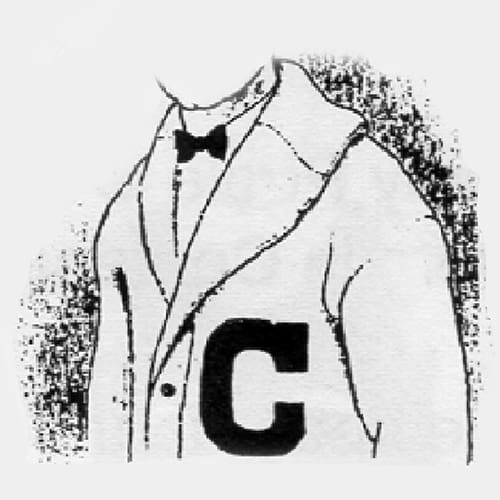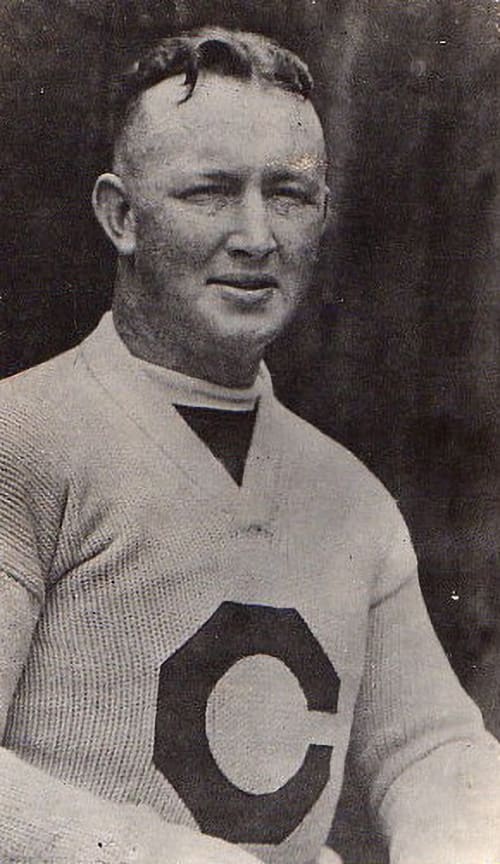Post-Season Happenings
Immediately after the South Carolina game, the local newspapers started a campaign for the Colonels to go to another post-season game out West.
Centre pointed out that the S. I. A. A. frowned on such appearances.
"But why?" was the reasoning. "It's during the Christmas vacation and the players won't miss any classes."
Of course, the papers were correct, and it seemed like a logical argument.
West Virginia and Gonzaga played in San Diego's second, and last, Christmas Bowl game. Southern Cal beat Penn State in the Rose Bowl, and that was it for games after the 1922 season. It was felt Centre most certainly could have gotten the invitation to the Rose Bowl if the school had lobbied for it, and been able to travel to California.
As it was, the promoters of the Pasadena New Year's Day event had to settle for a 6-3-1 Penn State team which had lost to Navy, Penn and Pittsburgh, and tied Syracuse. ( Penn State lost the Rose Bowl game to Southern California, 14-3. )
While Centre stayed at home, several of the former players didn't. There was another charity game in Columbus, Ohio. Army, who had been at Centenary assisting his old teammate, came up from Louisiana with Bo. Chick Murphy and Red went up from Danville. It was a reunion of Colonels who had put on the uniform together in so many contests over the years.
Bo captained the West team, and his squad won 6-0 in front of 20,000 spectators.

Bo, far right, in the backfield at 1922 charity game in Columbus, Ohio

Bo, far right, running the ball
At the annual football banquet, letters were handed out to:
Tom Bartlett
Charles Cecil
Herb Covington
Ben Cregor
Minos Gordy
Jim Green
Hope Hudgins
Clarence Jones
George Jones
Dewey Kimbel
Ed Kubale
Hennie Lemon
Jim Liggett
Howard Lynch
Red Roberts
Frank Rubarth
Bill Shadoan
Terry Snowday
Hump Tanner
Case Thomasson
Jerome Berryman-manager
After the awarding of the coveted gold "C" to the recipients, Dr. Charles Allen, Chairman of the Athletic Board, held up a white, collared sweater which had a gold "C" sewn on the left, front side.
"We feel honored to present this letter-sweater to our good friend, Mr. Howard Reynolds of the Boston "Post." Mr. Reynolds has kept the colors of Centre in the hearts of people all over the East. We now feel it proper that he wear our colors as a member of the Gold and White."

Howard Reynolds' Centre sweater which he wore so proudly
When word reached Boston, a large cartoon appeared in the "Post" showing a sweater flying through the air and wrapping its arms around a surprised Reynolds.
The caption: "Oh gosh, just look what happened to our sporting department."
Reynolds was interviewed.
"Not bad that a 44 year-old daddy can letter in football!"
He was so genuinely moved that he wired Dr. Allen that he was coming to Danville to accept the award in person.
"You know, I love to come to Danville and see all of my friends there. I'll be down in the spring."
Howard Reynolds, the best friend that Centre College ever had, indeed did take the long train ride down from Boston and was seen around town, beaming, as he greeted folks on the street, sporting his white sweater with the gold "C."
Uncle Charlie headed to his farm at Horse Cave after the banquet to do some serious bird hunting. He invited Herb Covington to come down and the Centre quarterback proved to be as accurate with a shotgun as he was at throwing a pass.
Dr. Allen kept the coach and the Chief informed about offers flooding into Danville wanting to put the Colonels on their schedule for 1923.
Michigan wanted a game in Ann Arbor. Alabama tried again to interest Centre.
Georgia sent word, "Come to Athens." Colgate wanted a game in New York and had Grantland Rice intervene on its behalf. Other writers in New York were promoting Centre and Penn in Yankee stadium as had been previously proposed.
There was a suggestion that Centre come to New Haven, but Yale let it be known that it would honor the pledge that it had made with other members of the "Big 3" that the Bulldogs wouldn't schedule any intersectional games.
How about Penn State rather than either Colgate or Penn at Yankee Stadium?
Clemson wanted a rematch, as did Auburn. The city of Louisville was lobbying for another visit by the Colonels. Memphis made an attractive offer for the Colonels to come south and play a Tennessee team, either Vandy, Tennessee or Sewanee, whichever could be arranged.
Interest in Centre only intensified when schools were looking to fill out their upcoming schedules when Harvard reported that the Crimson had played in front of record crowds and generated record income during the 1922 season, which was greatly helped by the sell-out with Centre.
Harvard played in front of 339,916 spectators which included the Yale game in New Haven at its immense Bowl which drew 74,913.
The 8 home games at Harvard Stadium had a total of 265,004 which included-
Princeton- 50,178
Dartmouth- 49,904
Centre- 48,842 ( It was generally accepted that there were over 50,000 actually at the game.) Middlebury- Holy Cross-
Bowdoin-
Florida-
Brown-
_______
116,080
Total 265,004
Harvard reported a 1922 net profit of nearly $400,000 which was the equivalent of nearly $7,000,000 in today's money. It stated that the income from the football program subsidized all of the other sports except baseball which needed no assistance.
Harvard grossed $76,684 on the Centre game, clearing $59,684 before expenses after paying Centre $17,000.
The 3 games with Centre certainly vindicated Howard Reynolds' belief that intersectional games were necessary in order to truly designate a "National Champion," as well as the fact that they not only could draw great interest, but perhaps as importantly. be extremely profitable.
Of course, Kentucky, Centre's biggest rival, was going to have to be penned in on the 1923 schedule.
There were two constants which were considered in planning the upcoming season. Centre hoped to have a new stadium in place, and to host teams in its new facility. Also, Uncle Charlie, the Chief and members of the athletic department wanted to have at least one big game in the East. The Harvard games had been such a positive force in building public awareness of the little college that everyone agreed that the publicity gained from playing a strong Eastern squad was essential.
Frank Menke's column in the Washington "Herald," published at the same time that Centre was working on the games for 1923, reinforced how Centre had benefited from its leap into big-time football.
Fully fifty percent of the tremendous increase in college enrollments in the past few years has been directly due to the interest in football. A perfect example is Centre College down in Kentucky. About 109,900,000 of the folks in these United States didn't know 3 or 4 years ago that such a place existed, but now, because of Bo McMillin and the other brilliant "Praying Colonels," Centre is one of the best known colleges in all of the land.
Bearing out Menke's assertion, Centre's rise to prominence in the world of college football, and thus in the public's awareness, paralleled its increased enrollment.
Class Enrollment
1918/19 134 ( Centre's S.A.T.C. war season)
1919/20 181 ( The big win over West Virginia )
1920/21 191 ( Harvard- 31 Centre-14 )
1921/22 262 ( Centre- 6 Harvard- 0 )
1922/23 284 ( Harvard- 24 Centre- 10 )
1923/24 292 ( The new stadium )
Dr. Ganfield and the Chief, if they read Menke's column, must have felt terribly vindicated. It was their original vision, nurtured by Uncle Charlie's brilliant coaching, that had allowed Centre to have the dream, to follow the motto, Credendo Vides, that allowed them to first believe, and then to see that belief become reality.
Walter Camp's 1922 All-American selections were published in Collier's in December. No Centre player made the first three teams, and Kentuckians were incensed. Only two Southerners gained any recognition. Lynn Bomar of Vanderbilt and Georgia Tech's "Red" Barron made the second team. As upset as the Kentuckians were about Centre being snubbed was the belief that it had been an injustice not to include the Harvard quarterback, Charles Buell, and to put the great Crimson fullback, George Owen, on the second team. Harvard did garner one first team selection, Charles Hubbard, at guard.
Camp put Red, Covey and Ed Kubale in the Honorable Mention grouping.
Heywood Broun, formerly with the New York "Tribune," but currently writing for the New York "World," placed Red at fullback and Covey at quarterback on his first team, greatly influenced by having seen their play against Harvard.
About the time that Camp's selections were appearing, the 214 coaches who voted and selected the team for the nationally distributed "Athletic World," picked Red as a first team tackle, and Covington as the second team quarterback.
"Who knows better than the coaches?" was the sentiment in Danville and around the state.
The "All-Southern," All- Southern team, compiled from the All-Southern teams picked by newspapers all across the South, gave Centre three unanimous selections- Red, Covey and Kubale.
And finally there was the publicity that Red Roberts received during the season by having a large photograph of him printed in the "Police Gazette." The "Gazette" was a nationally distributed tabloid with a circulation of 500,000, and millions of readers. You couldn't go into a barber shop, pool hall, or bar, ( or speakeasy after prohibition ), without seeing a copy of the "Police Gazette" lying around.

Nationally distributed

Red Roberts
There was a "splendid likeness of Old Nero, our Red Roberts," in the publication, according to the Danville "Messenger."
THE 1923 SCHEDULE IS ANNOUNCED
In January, after working through the Christmas vacation, Dr. Allen announced the schedule for 1923.
Oct. 6 Carson-Newman Danville
Oct. 13 Clemson Danville
Oct. 20 Oglethorpe ( Ga.) Danville
Oct. 27 Pennsylvania Philadelphia
Nov. 3 Kentucky Danville
Nov.10 Sewanee Memphis
Nov.17 Auburn Birmingham
Nov.24 Washington and Lee Louisville
Dec. 1 Georgia Athens
An important consideration was putting six members of the Southern Conference on the schedule- Clemson, Kentucky, Sewanee, Auburn, W&L and Georgia. Centre again wanted to be in a position of playing enough of the conference's team that if it could defeat them, the little school, left behind in the small college S.I.A.A., could again make the claim of being the "Class of the South."
